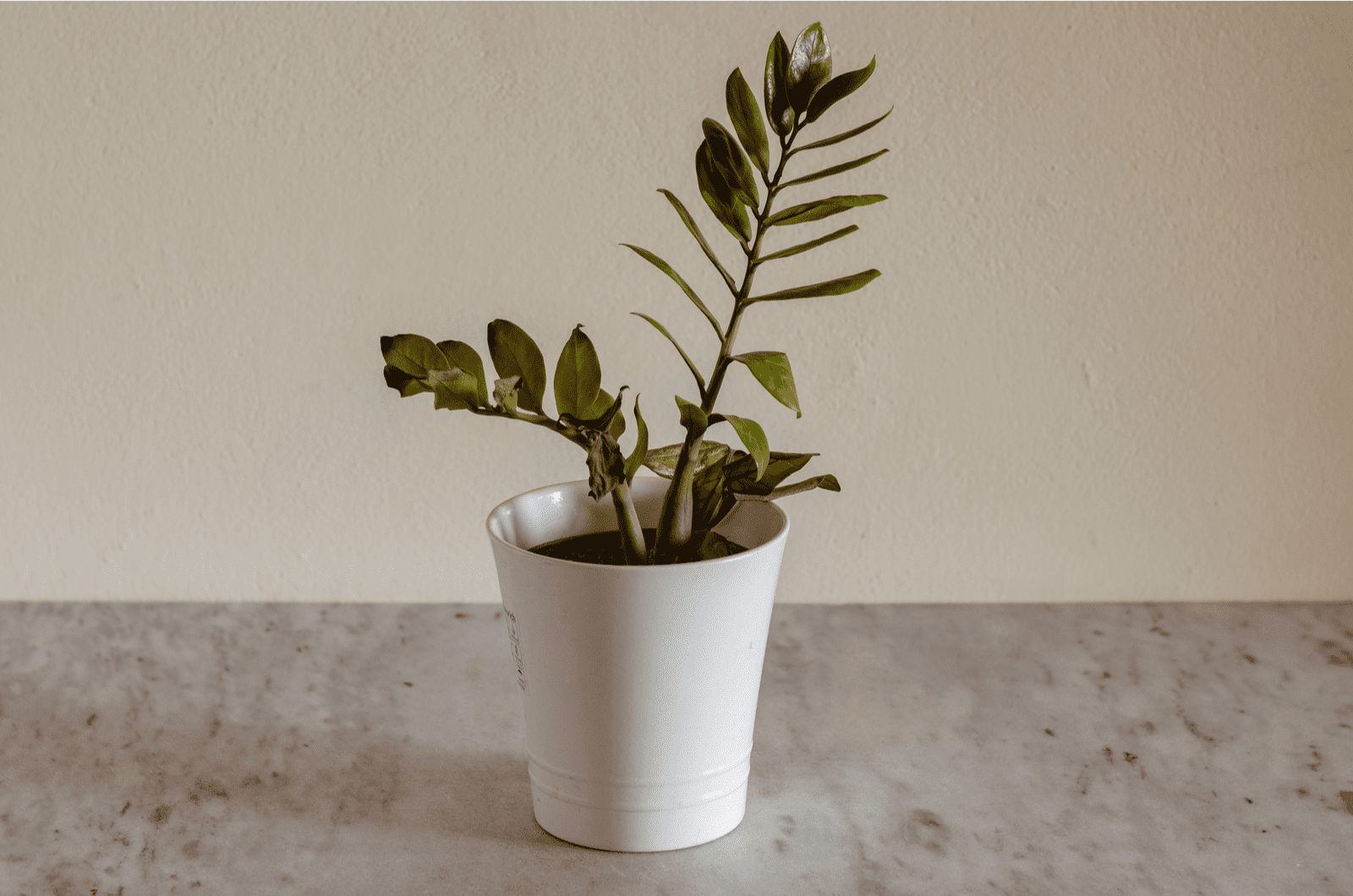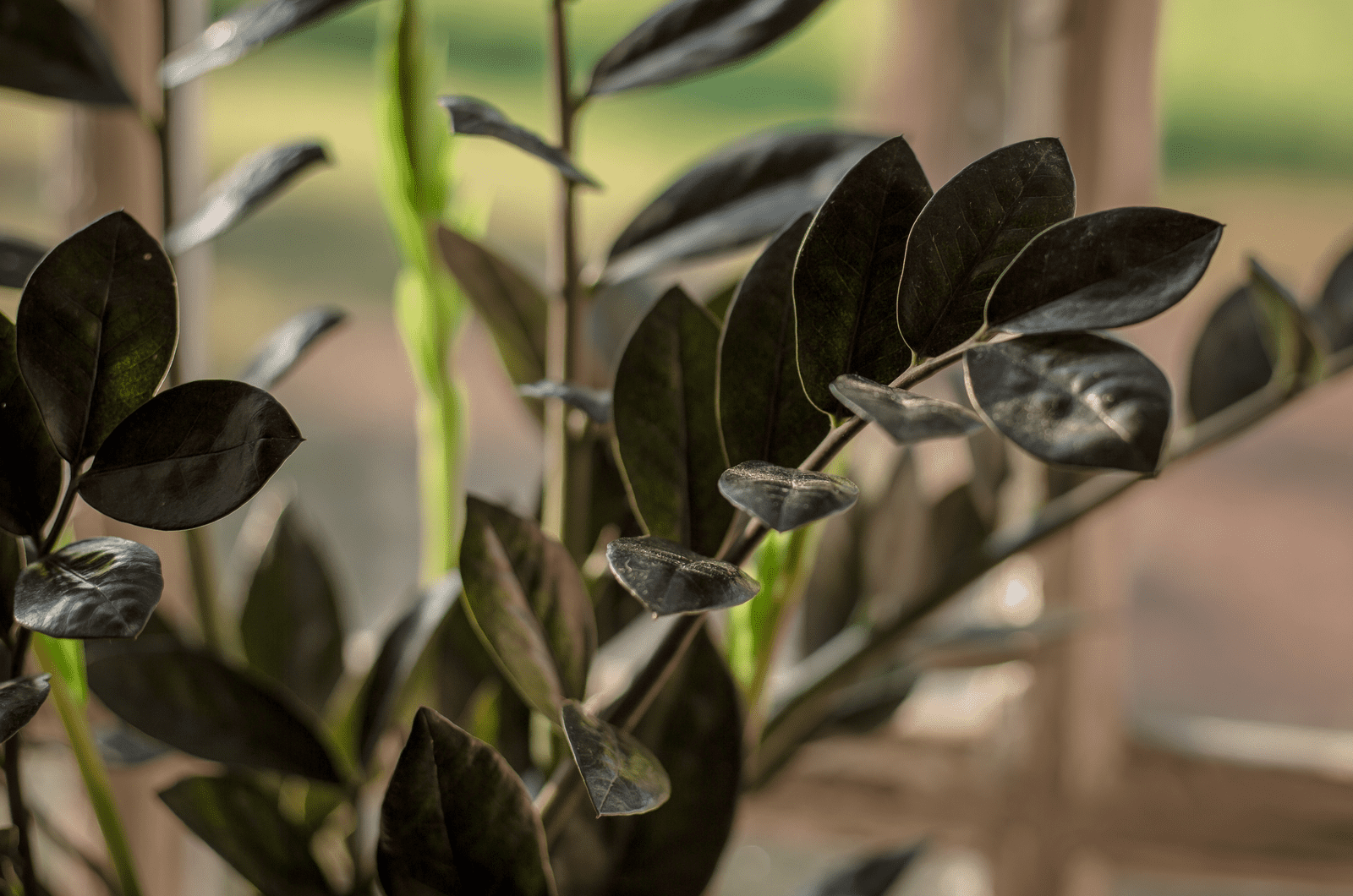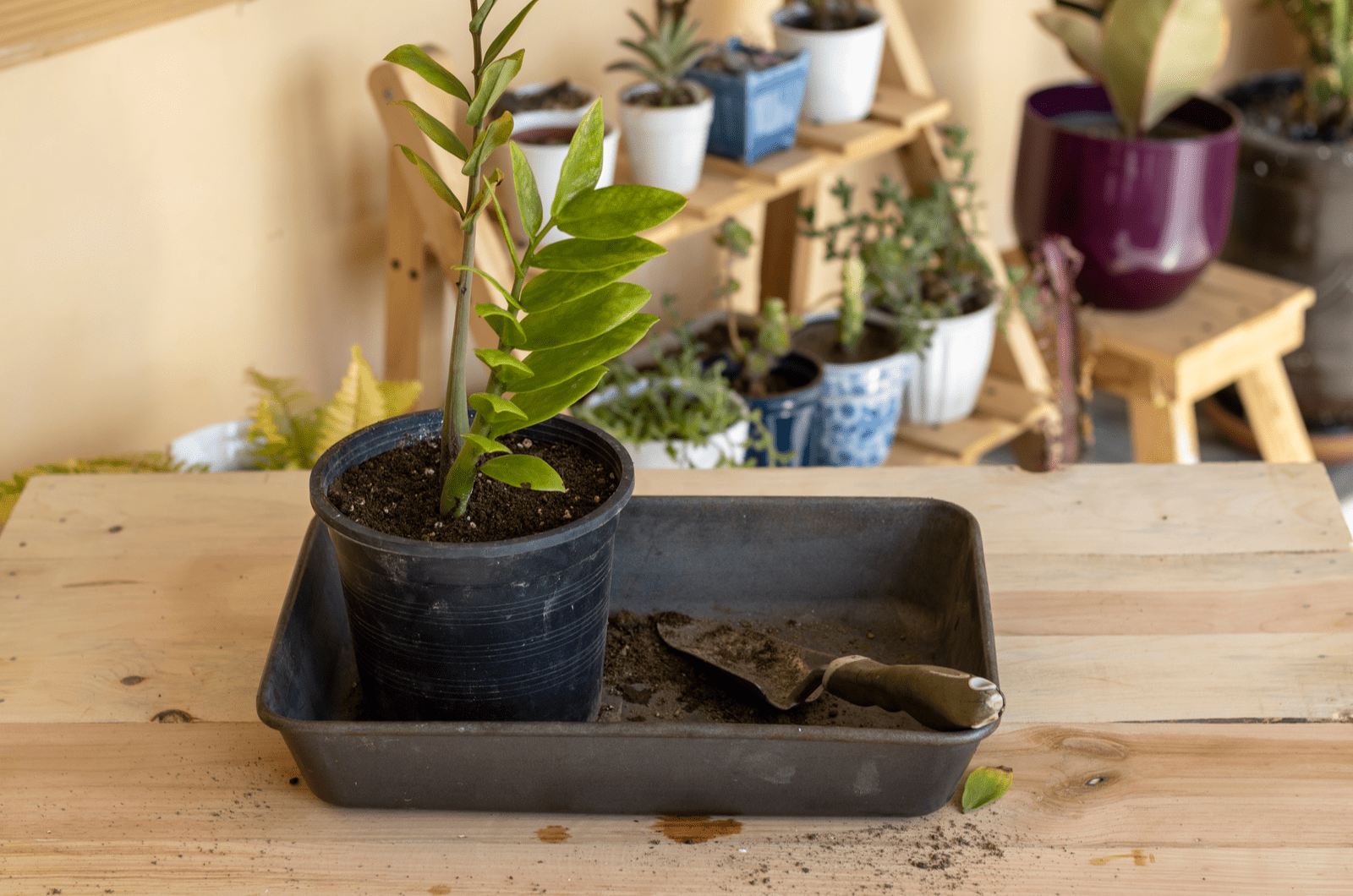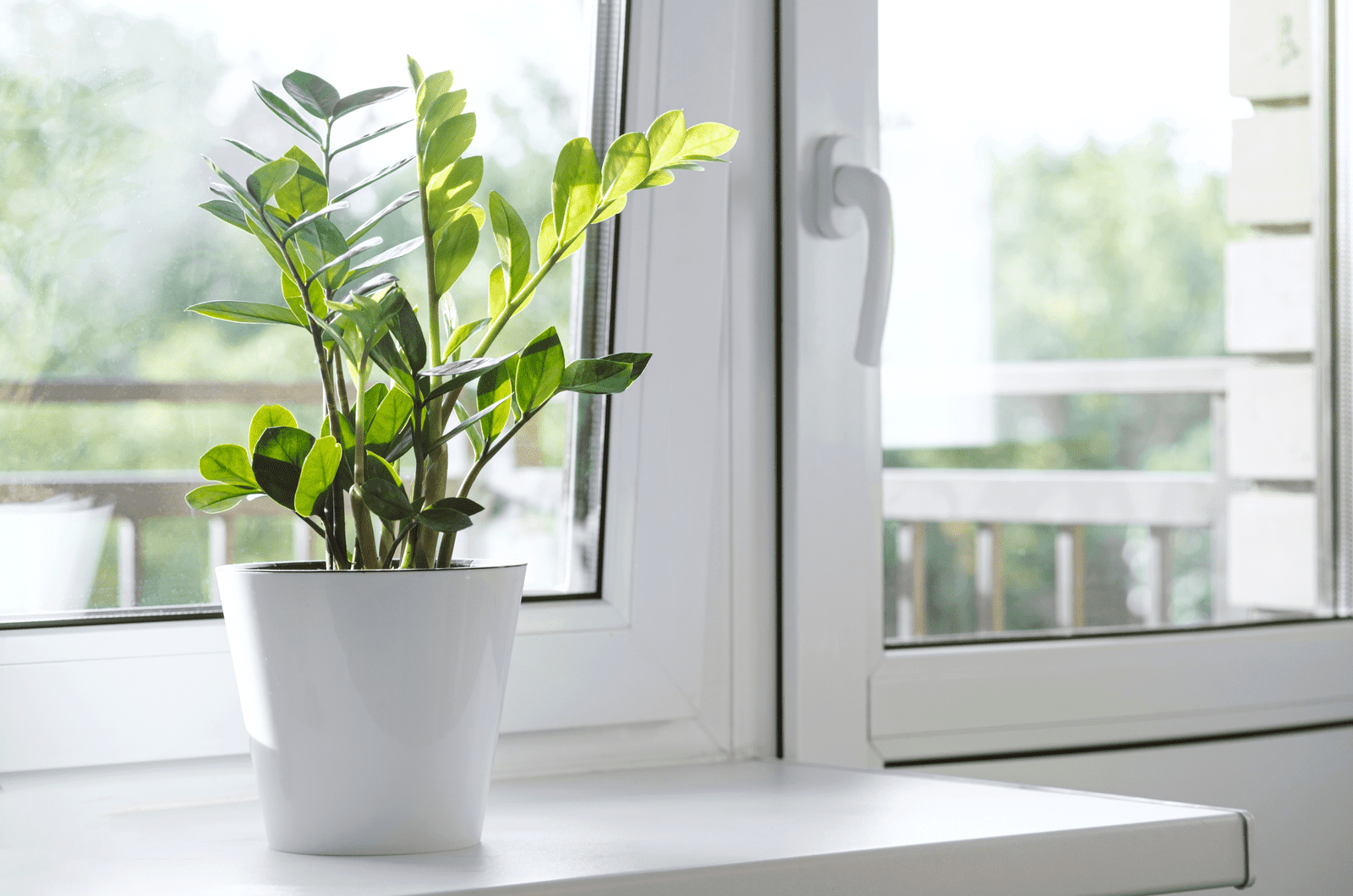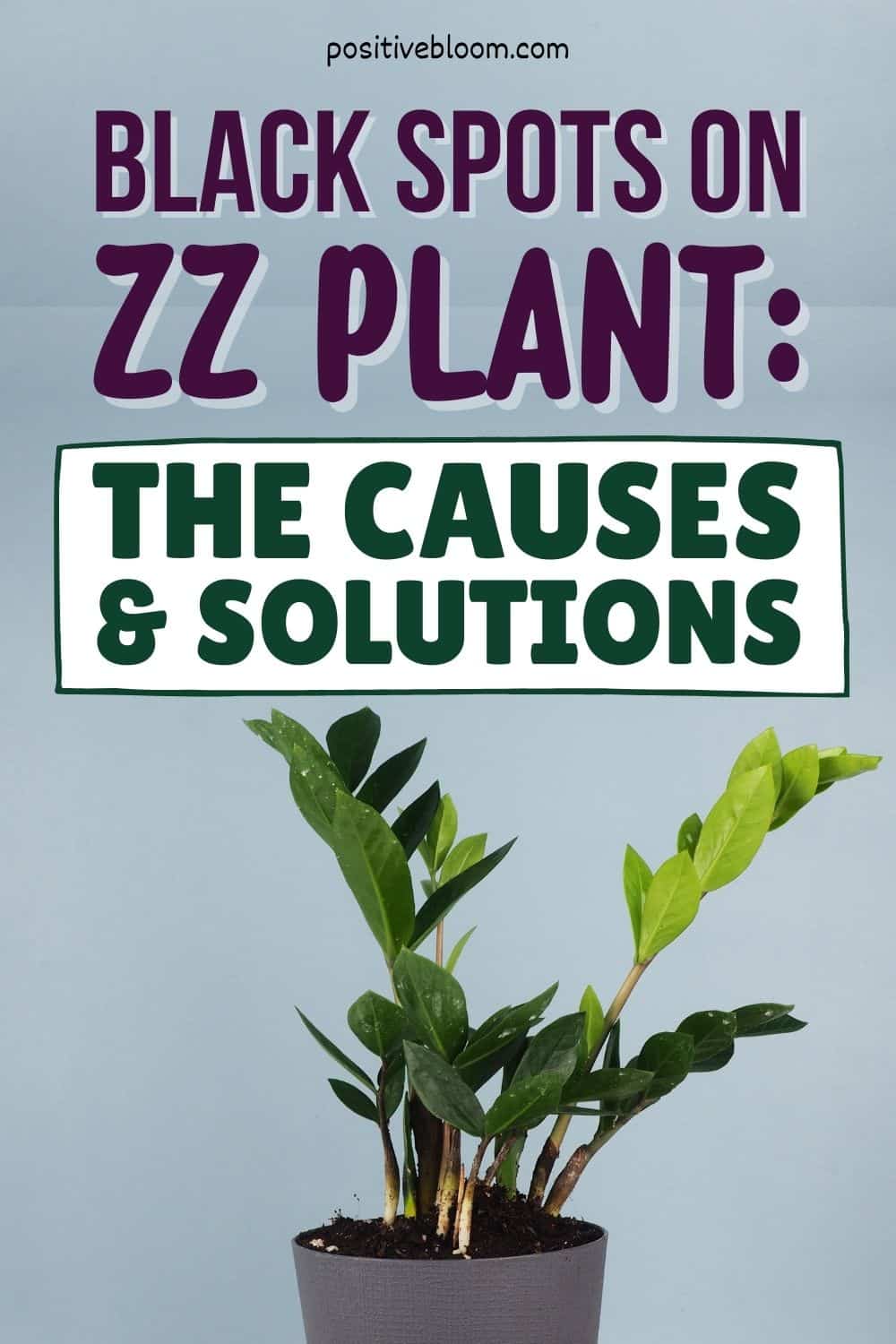When someone mentions the ZZ plant, most experienced gardeners think of its low-maintenance requirements.
Indeed, this plant is one of the easiest plants to care for. However, it’s not entirely resistant and will let you know if it’s unhappy!
For example, if you notice black spots on ZZ plant, something is definitely wrong. Black spots may appear on the leaves, stem, and even over the entire plant.
I made a list of possible causes of blackening; some are very frequent, while others are less typical.
I will also provide you with the solutions to these issues, as well as some tips for ZZ plant care so that the blackening doesn’t come back.
Before we move on, let’s look at some basic info about this plant.
[table id=195 /]
Let’s get started!
Black Spots On ZZ Plant: Causes
Whenever you notice anything black on your plants, you should act immediately. Blackness and green leaves are not a good combination.
So, if you notice black blotches on ZZ plant leaves, here are the possible causes:
Black Spots On Leaves
If you notice this kind of leaf discoloration, you should check your watering and fertilizing schedules, as well as humidity and light levels.
Let’s get into more detail!
Direct Sunlight
The ZZ plant is tropical, and when it grows in its native habitat the leaves are protected by the rainforest canopy. This means that they are not exposed to direct sunlight.
Bear in mind that the leaves of this plant are delicate and light-sensitive. This means that it won’t take much time for them to react to direct sunlight, even if they are not exposed for an extended period.
You will first notice scorching, followed by black blotches.
However, a few spots on the leaves won’t cause much damage to the overall health of the ZZ plant.
On the other hand, if the blotches spread and entire leaves start turning black or brown, your plant has been exposed to direct light for too long. This is a serious condition, and if left untreated for an extended period the leaves will die off and the entire plant will be affected.
Be very careful as this may be fatal for your plant.
Overwatering
Although it may seem like the ZZ plant is impossible to kill, trust me, that’s not the case. The worst enemy of ZZ plants is overwatering.
When your Zanzibar gem receives too much water, the soil becomes soggy. For the ZZ plant, overly wet soil means a restriction of the oxygen essential for healthy root growth.
Plants take in carbon dioxide, but the question is: why do they need oxygen?
It’s because photosynthesis has a positive outcome if the plant receives enough oxygen.
Put simply, excess water around the roots prevents them from taking in oxygen. As a result, suffocated roots can’t send nutrients to the other parts of the ZZ plant. The leaves will develop black blotches if they don’t receive enough nutrients.
Overwatered ZZ Plant
Other signs of overwatering include:
• Yellow leaves
• Mushy soil
• Brown stalks
• Drooping leaves
Soggy soil not only causes oxygen restriction, but also creates an ideal environment for diseases caused by fungus. These infections lead to root or stem rot, which can kill your plant.
Underwatering
Compared to other tropical plants, the ZZ plant isn’t a heavy drinker. But that doesn’t mean the plant will grow healthily without water.
Although it may be hard to believe, underwatering can be almost as dangerous as overwatering!
In case of underwatering, the black or brown blotches will most likely appear near leaf edges or tips.
This is one of the signs of dehydration.
Other signs of an underwatered ZZ plant include:
• Wilting
• Drooping
• Curling.
If you think that a lack of water is causing the blackening, double check because the signs of underwatering are very similar to those of overwatering.
To be sure, inspect the soil; if it’s dry to touch, your eternity plant is lacking water. If it’s wet, delay watering because you’re dealing with an overwatered ZZ plant.
It is essential to detect which of the two extremes has caused damage. We hope it’s underwatering because an overwatered ZZ plant is a bigger problem.
Low Humidity
We know that humidity levels cause black or brown spots to appear rapidly.
Blackening or browning is caused by low humidity levels.
Dry air causes the water to evaporate quickly, so the leaves lose water rapidly. As a result, they display black blotches and fall off.
ZZ plants tolerate lower humidity levels better than most other common houseplants, but not if the humidity drops below 40%.
Overfertilization
ZZ plants are not heavy-feeders, and they can even survive if you don’t fertilize them at all.
However, there’s nothing wrong with giving them a boost from time to time.
If you fertilize your eternity plant too frequently, it will most likely develop yellow leaves that may be followed by brown tips and spots.
Additionally, overfertilization leads to brown leaves.
This primarily occurs during the fall and winter as plants don’t require fertilizer when not growing actively.
Black Spots On ZZ Plant Stem
Black blotches may also appear on the ZZ plant stem.
Let’s find out why!
Stem Rot
Stem rot is one of the most serious conditions that affects houseplants, and black blotches are one of the signs of stem rot.
However, some other issues may occur, such as slimy or mushy stems.
Poor watering habits are the most common cause of the blackening of different parts of plants. This is because excess water in the soil creates an ideal environment for fungus.
For ZZ plants there is one more issue – excess water around the stem. You may be wondering how on earth this is possible!
The answer is pretty simple: watering your plant from above will create pools around the bottom part of the stem, which causes it to rot.
Some varieties of fungus, like the ones from the Phytophthora and Fusarium genera, thrive in moist soil, which means overwatering promotes their growth.
Root Rot
Here comes the nightmare of every gardener in the world – the notorious root rot!
Root rot is caused by a fungus that can be found in the air, soil, and water.
Bear in mind that stem rot and root rot often occur together, so if you spot black blotches on the stem you must also check the root system.
The easiest way to detect if your plant is suffering from root rot is by checking the moisture level after the black blotches occur.
Improper irrigation causes serious damage to your plant. Fungi from the Phytophthora genus mostly affect ZZ plants, and cause root rot.
Low light is another problem for the ZZ plant. Bright indirect light prevents the plant from uptaking the necessary nutrients.
When roots are affected by fungus, they will stop taking and sending nutrients to the other parts of your Zanzibar gem plant.
As a result, the plant loses its strength and eventually dies.
Direct Sunlight
Light that is either too bright or direct won’t do your eternity plant any good. ZZ plant leaves are susceptible to light, and the same applies to the stem.
If your plant is exposed to full sun for too long, it may develop black blotches on the stems.
However, this might not cause any damage to your plant, nor does it indicate any serious problems.
This is the plant telling you it doesn’t need that much light.
Black Spots Over The Entire Plant
We’ve seen how black blotches can appear on both the leaves and the stem.
However, blackening can also occur all over your ZZ plant.
Don’t panic immediately; first, inspect your plant carefully.
Let’s see the possible culprits!
Diseases
One of the possible culprits for black blotches on the ZZ plant is a fungal disease known as sooty mold.
Three fungi may be the possible causes of sooty mold: Scorias, Fumago, and Capnodium.
These fungi grow on plants that have been coated with honeydew. Some insects cause this sticky substance, and the fungi growth resembles a covering of soot.
Although this condition looks pretty unattractive, it isn’t very dangerous. However, insects that produce honeydew can be a big issue.
The dark and powdery substance affects each part of the eternity plant, and it is a sure sign of sooty mold.
A much bigger issue can cause fungi like Pythium, Rhizoctonia, Fusarium, and Phytophthora. They may cause root rot, stem rot, or another more serious fungal infection known as fungal leaf spot.
Each infection may result in black spots on the leaves, stem, or both.
However, bacterial infections can also be the cause of black blotches, and in this case, bacterial leaf disease is another potential culprit.
Pest Infestation
Although the ZZ plant isn’t susceptible to pests, some can appear. Some indoor plants are more susceptible to pests than others, and if these plants suffer from infestation they can quickly transfer to your ZZ plant.
If you suspect your plant has an infestation, look for aphids or scales as they mostly affect these plants.
Aphids
One or two aphids aren’t much of a problem, but if they bring friends your plant is in serious danger.
Aphids have sucking mouths they use to feed on the ZZ plant. After they’re done eating, the black blotches may appear.
I know what you are thinking: these creatures are pretty gross – but fortunately, you shouldn’t have much trouble getting rid of these soft-bodied pests.
Scales
And the award for the most annoying pest goes to…scales! Scales are tiny creatures that can walk even in their immature stages.
They are pretty hard to spot as they stick tight to the plant. Additionally, these pests are tenacious, so you won’t get rid of them easily.
Immature scales first look for a perfect spot on a ZZ plant to inhabit. They will most likely choose the undersides of the leaves or stems.
When they find an ideal spot, they grow up and lose their ability to walk. Then they start taking the nutrients from your plant, which causes black blotches.
How To Save Your Zamioculcas zamiifolia
After you identify the cause of the spots, it’s time to get to work!
Different cause=different solution.
Let’s see how to deal with each cause.
Relocate The Plant
If bright light causes the issue, you should consider moving your plant to a less bright spot.
This may not remove the blotches, but it will prevent your plant from developing new ones.
ZZ plants tolerate low-light environments better than many other common indoor plants. However, they still require some light to thrive, and the Zanzibar gem won’t grow new leaves if the light is too low.
It is best to keep your ZZ plant somewhere that receives at least 12 hours of indirect light per day.
Eternity plants despise direct sunlight, so make sure to find a spot that won’t receive any. Place your plant a few feet from the window.
If you decide to put it near a south-facing window, make sure to put curtains up. The ZZ is a perfect plant for offices without windows!
Repot Your Plant
ZZ plants require repotting every 2 years as they may become rootbound and develop rhizomes that occupy a lot of room in the pot. The problem is that a rootbound ZZ plant is more susceptible to root and stem rot.
These are the situations in which repotting is a must:
1. A rootbound ZZ
2. Stem rot
3. Root rot
The solution is repotting, so let’s find out how to repot the Zanzibar gem!
Take The ZZ Out Of The Pot
• Carefully remove your eternity plant from its pot. Never pull your plant, but instead flip it over and let it slide down.
• Throw away the old potting soil as it may be contaminated. Choose a slightly acidic and well-draining potting mix.
You can use standard potting soil and add some perlite and coarse sand to improve drainage, or a succulent soil mix.
• Inspect your ZZ. Now is an excellent time to check the ZZ plant roots. Look for any mushy and discolored roots. These are the symptoms of root rot, and you will need to remove the affected roots carefully.
• Wash the root ball to get rid of any extra soil as this will allow you to see the roots. Sterilize your scissors and start removing the affected roots. After you remove the affected roots, spray fungicide on the root system.
Pro tip: Check the rhizomes and see if you can propagate your ZZ by division.
Place ZZ In New Soil
• Take a new pot, preferably made of terracotta, and fill 1/3 of it with new soil. Put your Zanzibar gem in the center of the soil mix.
The roots should have enough space to grow without becoming rootbound, so make sure to leave some soil between the ZZ roots and the bottom of the new pot.
• Add more soil to fill the pot entirely, and don’t worry if some of the rhizomes peek through the soil as it prevents stem rot.
Change Watering Habits
The first thing you need to remember is that you should never water your ZZ without first checking the soil.
Although a fixed watering schedule may sound like a good idea, it actually isn’t.
The amount of water your ZZ needs depends on many conditions, such as light, humidity, and temperature.
Instead, make it a routine to inspect your eternity plant every day for indicators that your plant is thirsty.
How To Check If A ZZ Needs Water
There are 4 ways to determine if your ZZ plant needs water:
1. Pot weight: If it feels heavy, delay watering for some time.
2. Dry topsoil: You can check if the soil is dry by putting your finger or a stick in the soil. If it is dry, it’s time for watering. However, never let your ZZ’s soil dry out completely.
3. Soil color: If the soil is darker, there is no need to water it yet.
4. Moisture level: To check the moisture level, consider getting a moisture meter.
In case of overwatering, you should repot your ZZ using our methods from the section above.
In case of underwatering, water your ZZ thoroughly every week.
To avoid unnecessary issues, always purchase a pot for your ZZ with drainage holes (or make some yourself if you find a cute cachepot without any).
How To Water A ZZ Plant?
I highly recommend bottom watering your ZZ plant.
This is an excellent approach to providing your plants with enough water without drowning their leaves. It guarantees that the essential roots near the bottom get enough water, which is difficult to achieve if you water your ZZ from the top.
There are several ways to deep water your ZZ.
First, you should get a container that the ZZ’s pot fits in, just make sure there’s a little space around the pot.
Another option is to use the pot’s saucer. You just need to fill the saucer/container with water (not too much) and place the ZZ pot in it. Now, let your ZZ sit for a little until the soil is wet below the surface.
It takes about 10 minutes for the soil to become wet enough. It may take longer, just don’t forget about it because you need to remove the excess water in the saucer.
In the case of a container, take your ZZ plant’s pot out.
The advantage of this watering method is that it gradually soaks the soil without overwatering it.
Change Fertilizing Habits
As mentioned, the Zanzibar gem isn’t a heavy feeder.
However, if you decide to give a boost to your ZZ, there is an ideal fertilization schedule.
ZZ plants grow actively during spring and summer, which is their growing season, and only then do they need food.
Never fertilize your ZZ during its dormancy period (the winter months). The plant doesn’t use energy, so it doesn’t need food.
Wait until spring when you notice new growth.
There is no need for a special fertilizer; all-purpose liquid fertilizer for houseplants will do wonders!
Adjust Humidity
The ZZ plant can tolerate moderate humidity levels typically ranging from 40 to 50%.
However, it’s better to keep humidity slightly above the upper line than let it drop below 40%.
You should increase it if you notice dark spots on your ZZ’s leaves and conclude that humidity is the problem.
There are a couple of ways to do it.
First, you can use a pebble/humidity tray – just place it below the ZZ’s pot and fill it with pebbles. Add water and make sure the ZZ plant’s roots don’t touch the water.
Another way is providing your ZZ with the company. In other words, place your ZZ next to other plants. If you also grow snake plants or spider plants, your ZZ will enjoy spending time with them.
You can also place your ZZ in a kitchen or bathroom, which have naturally higher humidity.
If unsure, get yourself a humidifier.
Pest Control
You will need a horticultural soap or Castille liquid soap to remove aphids.
You will need about 2 teaspoons of Castille soap for a gallon of water.
Apply the solution to your ZZ every few days until you see signs of improvement.
Rubbing alcohol is also a way you can remove these tiny creatures; simply rub these soft-bodied creatures off your ZZ.
For immature scales, a combination of soap and water should do fine.
However, when these nasty pests grow up you will need a soft brush to remove them. Also, prune the affected leaves and discard them; please don’t add them to your compost bin!
Some horticultural oils, such as neem oil, can also be used. Spray neem oil solution on your ZZ every 4-7 days until you notice signs of improvement.
Wrapping Up
The ZZ plant is a very common houseplant because it’s easy to care for and looks fascinating.
I highly recommend growing a ZZ if you are a beginner. Guess what? A ZZ may grow new stems and new shoots if you provide it with good conditions!
But remember, the ZZ is a houseplant and may have some issues if you don’t provide its basic conditions.
One of those issues is black spots on ZZ plant. This is a tricky situation as there can be many reasons for it.
But now you have our methods, and I assure you that if you use our tips your eternity plant will be thriving in no time!
Until next time!
Like this post? Share or pin it for later!

